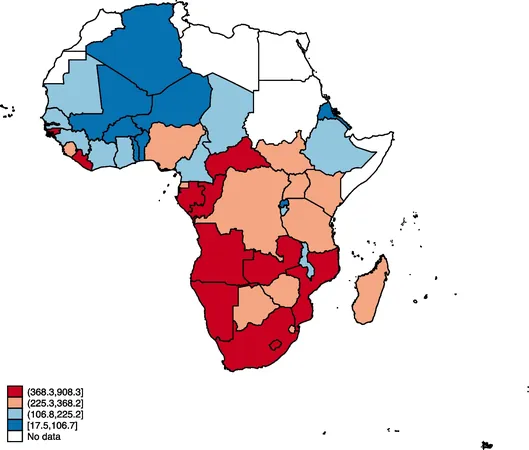
South American Space Programs: The Urgent Need for Collaboration
2025-01-21
Author: Ming
Introduction
In recent years, global space initiatives have highlighted the importance of cooperation in harnessing the power of space technology. Nations worldwide understand that large-scale space projects often serve as a reflection of broader geopolitical strategies. For instance, the European Space Agency (ESA) is a pivotal representation of European political and economic integration, while Russia's early involvement in the International Space Station (ISS) was crucial for showcasing its commitment to global non-proliferation efforts following the collapse of the Soviet Union.
The Context of South American Space Programs
Today, the Artemis agreements forged between the United States and over 50 countries exemplify how nations can unify their efforts in space exploration amidst fierce competition from powers like China and Russia. But the pressing question arises: how can South American countries leverage space cooperation within their geopolitical narratives?
State of Space Programs in South America
To provide context, let's delve into the state of space programs across South America. Over the past 32 years, ten South American nations have developed approximately 115 satellites. These range from simple CubeSats deployed by Ecuador, Uruguay, Colombia, and Paraguay, to advanced optical and geostationary satellites utilized by countries such as Chile, Peru, Bolivia, and Venezuela—often acquired from European or Chinese suppliers. Argentina and Brazil have made strides with local satellite design and assembly, collectively launching 21 homegrown satellites.
The Need for Collaboration
Despite these advancements, it is alarming to note that none of the more than 100 satellites in the region were collaboratively developed between two South American nations. Argentina collaborated with the United States in the 1990s to produce its first four scientific satellites, which came about as a consequence of curbing its military nuclear ambitions. Meanwhile, Brazil has enjoyed a longstanding partnership with China, culminating in the launch of multiple Earth-resources satellites.
Challenges and Missed Opportunities
Ambitious endeavors like the SABIA-Mar mission, proposed two decades ago to research the oceanic biosphere, have languished without adequate funding. Instead, countries in the region have increasingly turned to external partners; China, for example, has become a major supplier of high-resolution satellites to Venezuela and Bolivia, while European firms provide optical satellites to Chile and Peru. Japan's support allowed Paraguay to launch its inaugural CubeSat in 2021.
Understanding the Paradox
The central paradox remains: why has binational space cooperation failed to take off in South America? The reasons are multifaceted, prominently featuring economic instability and a lack of a robust astropolitical culture. During the commodities boom from 2004 to 2020, seven South American nations pioneered space missions, yet the current economic climate presents significant challenges which stifle new developments.
Technological Advantages and Disparities
Argentina possesses a technological edge in satellite construction, alongside the emergence of innovative companies such as Satellogic, which specializes in commercial high-resolution imagery. Although both Argentina and Brazil have comprehensive capabilities for producing various types of satellites, they lack cohesive and forward-thinking space policies that could elevate their status as reliable international partners.
Future Directions for Collaboration
In the meantime, nations like Peru and Colombia are advancing plans to establish their satellite programs, while Bolivia, Chile, Peru, and Venezuela face challenges in replacing aging technology. As they navigate these decisions, these countries are likely to seek partnerships with more established powerhouses in North America, Europe, and Asia.
Conclusion
Ultimately, Argentina and Brazil must intensify their efforts to foster regional collaboration and establish reputations that could facilitate mutual benefits in the space industry. Without a cohesive approach, South America stands to lose valuable opportunities in the realm of space exploration, leaving the region’s potential largely untapped.
In a world where space exploration is increasingly seen as a collective endeavor, the stakes are too high for South America to remain stagnant. It is crucial for policymakers and industry leaders in the region to join forces to cultivate an environment conducive to shared initiatives, ensuring that South America does not fall further behind in the race for cosmic discovery.




 Brasil (PT)
Brasil (PT)
 Canada (EN)
Canada (EN)
 Chile (ES)
Chile (ES)
 Česko (CS)
Česko (CS)
 대한민국 (KO)
대한민국 (KO)
 España (ES)
España (ES)
 France (FR)
France (FR)
 Hong Kong (EN)
Hong Kong (EN)
 Italia (IT)
Italia (IT)
 日本 (JA)
日本 (JA)
 Magyarország (HU)
Magyarország (HU)
 Norge (NO)
Norge (NO)
 Polska (PL)
Polska (PL)
 Schweiz (DE)
Schweiz (DE)
 Singapore (EN)
Singapore (EN)
 Sverige (SV)
Sverige (SV)
 Suomi (FI)
Suomi (FI)
 Türkiye (TR)
Türkiye (TR)
 الإمارات العربية المتحدة (AR)
الإمارات العربية المتحدة (AR)